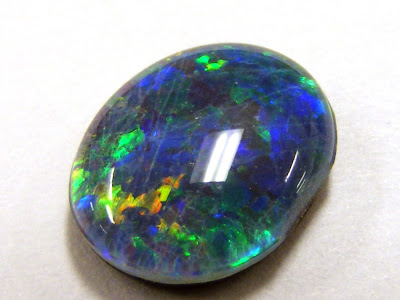
Opal is a hydrated amorphous form of silica; its water content may range from 3 to 21% by weight, but is usually between 6 and 10%. Because of its amorphous character, it is classed as a mineraloid, unlike the other crystalline forms of silica, which are classed as minerals. It is deposited at a relatively low temperature and may occur in the fissures of almost any kind of rock, being most commonly found with limonite, sandstone, rhyolite, marl, and basalt.
Opal is the national gemstone of Australia. Australian opal has often been cited as accounting for 95-97% of the world’s supply of precious opal, with the state of South Australia accounting for 80% of the world’s supply. Recent data suggests that the world supply of precious opal may have changed. In 2012, Ethiopian opal production was estimated to be 14,000 kg (31,000 lb) by the United States Geological Survey. USGS data from the same period (2012), reveals that Australian opal production to be $41 million. Because of the units of measurement, it is not possible to directly compare Australian and Ethiopian opal production, but these data and others suggest that the traditional percentages given for Australian opal production may be overstated. Yet, the validity of data in the USGS report appears to conflict with that of Laurs and others and Mesfin, who estimated the 2012 Ethiopian opal output (from Wegal Tena) to be only 750 kg (1,650 lb).
The internal structure of precious opal makes it diffract light; depending on the conditions in which it formed, it can take on many colors. Precious opal ranges from clear through white, gray, red, orange, yellow, green, blue, magenta, rose, pink, slate, olive, brown, and black. Of these hues, the reds against black are the most rare, whereas white and greens are the most common. It varies in optical density from opaque to semitransparent.
Common opal, called “potch” by miners, does not show the display of color exhibited in precious opal.
Naming
The word ‘opal’ is adapted from the Roman term opalus, but the origin of this word is a matter of debate. However, most modern references suggest it is adapted from the Sanskrit word úpala.
References to the gem are made by Pliny the Elder. It is suggested to have been adapted from Ops, the wife of Saturn and goddess of fertility. The portion of Saturnalia devoted to Ops was “Opalia”, similar to opalus.
Another common claim that the term is adapted from the Greek word, opallios. This word has two meanings, one is related to “seeing” and forms the basis of the English words like “opaque”; the other is “other” as in “alias” and “alter”. It is claimed that opalus combined these uses, meaning “to see a change in color”. However, historians have noted the first appearances of opallios do not occur until after the Romans had taken over the Greek states in 180 BC, and they had previously used the term paederos.
However, the argument for the Sanskrit origin is strong. The term first appears in Roman references around 250 BC, at a time when the opal was valued above all other gems. The opals were supplied by traders from the Bosporus, who claimed the gems were being supplied from India. Before this the stone was referred to by a variety of names, but these fell from use after 250 BC.
Precious opal
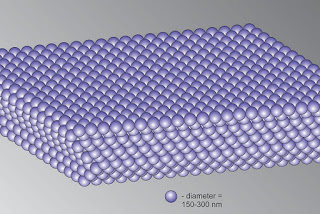
Precious opal shows a variable interplay of internal colors, and though it is a mineraloid, it has an internal structure. At microscopic scales, precious opal is composed of silica spheres some 150 to 300 nm in diameter in a hexagonal or cubic close-packed lattice. These ordered silica spheres produce the internal colors by causing the interference and diffraction of light passing through the microstructure of the opal. The regularity of the sizes and the packing of these spheres determines the quality of precious opal. Where the distance between the regularly packed planes of spheres is around half the wavelength of a component of visible light, the light of that wavelength may be subject to diffraction from the grating created by the stacked planes. The colors that are observed are determined by the spacing between the planes and the orientation of planes with respect to the incident light. The process can be described by Bragg’s law of diffraction.
Visible light of diffracted wavelengths cannot pass through large thicknesses of the opal. This is the basis of the optical band gap in a photonic crystal, of which opal is the best-known natural example. In addition, microfractures may be filled with secondary silica and form thin lamellae inside the opal during solidification. The term opalescence is commonly and erroneously used to describe this unique and beautiful phenomenon, which is correctly termed play of color. Contrarily, opalescence is correctly applied to the milky, turbid appearance of common or potch opal. Potch does not show a play of color.
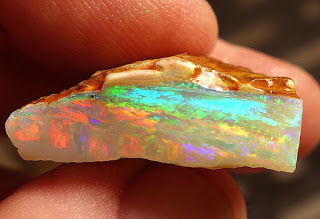
For gemstone use, most opal is cut and polished to form a cabochon. “Solid” opal refers to polished stones consisting wholly of precious opal. Opals too thin to produce a “solid” may be combined with other materials to form attractive gems. An opal doublet consists of a relatively thin layer of precious opal, backed by a layer of dark-colored material, most commonly ironstone, dark or black common opal (potch), onyx, or obsidian. The darker backing emphasizes the play of color, and results in a more attractive display than a lighter potch. An opal triplet is similar to a doublet, but has a third layer, a domed cap of clear quartz or plastic on the top. The cap takes a high polish and acts as a protective layer for the opal. The top layer also acts as a magnifier, to emphasize the play of color of the opal beneath, which is often of lower quality. Triplet opals therefore have a more artificial appearance, and are not classed as precious opal. Jewelry applications of precious opal can be somewhat limited by opal’s sensitivity to heat due primarily to its relatively high water content and predisposition to scratching.
Combined with modern techniques of polishing, doublet opal produces a similar effect to black or boulder opal at a fraction of the price. Doublet opal also has the added benefit of having genuine opal as the top visible and touchable layer, unlike triplet opals.
Types of Opal
Black Opal
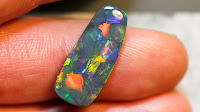
Black opal is characterised by a dark body tone causing brightness of colour which is unmatched by lighter opals. Black Opals are usually mined in Lightning Ridge, New South Wales, and are the most famous, and sought-after type of opal. The term ‘black opal’ does not mean that the stone is completely black (a common mistake), it simply means the stone has a dark body tone in comparison to a white opal.
Australian black opals are the most valuable and widely known type of opal. Black opal is characterised by a dark body tone which can range from dark grey to jet black. (See the following chart). However this refers only to the general body tone of the stone, and is not related to the rainbow or spectral colours present in the opal. Some people expect a black opal to be completely black (in which case it would be completely worthless).

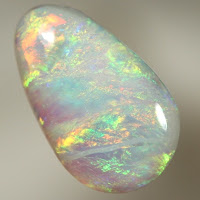
White Opal
Also known as ‘milky opal’, white opal features light white body tones, and is mined in South Australia. White opal is more common and because of its body tone, generally does not show the colour as well as black opal. Nevertheless, white opals can still be absolutely magnificent in colour if a good quality stone is found.
Boulder Opal
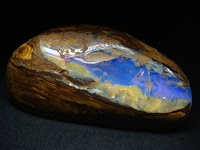
Boulder opal forms on ironstone boulders in Queensland. This type of opal is often cut with the ironstone left on the back, as the opal seam is usually quite thin. Leaving the ironstone on the back means that boulder opal can be very dark and beautiful in colour. The opal forms within the cavities of the boulders in both vertical and horizontal cracks. Boulders vary in shape and size, from as small as a pea, to as big as a family car. Boulder Opal has a tendency to cleave; when cleaved the “split” leaves two faces of opal, with a naturally polished face.
Crystal Opal
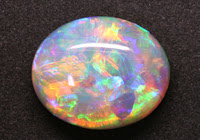
Crystal opal is any of the above kind of opal which has a transparent or semi-transparent body tone – i.e. you can see through the stone. Crystal opal can have a dark or light body tone, leading to the terms “black crystal opal” and “white crystal opal”.
Fire opal
Is a transparent to translucent opal, with warm body colors of yellow to orange to red. Although it does not usually show any play of color, occasionally a stone will exhibit bright
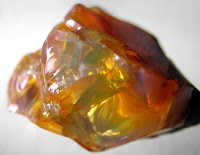
green flashes. The most famous source of fire opals is the state of Querétaro in Mexico; these opals are commonly called Mexican fire opals. Fire opals that do not show play of color are sometimes referred to as jelly opals. Mexican opals are sometimes cut in their ryholitic host material if it is hard enough to allow cutting and polishing. This type of Mexican opal is referred to as a Cantera opal. Also, a type of opal from Mexico, referred to as Mexican water opal, is a colorless opal which exhibits either a bluish or golden internal sheen.
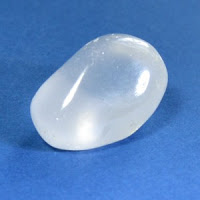 Girasol opal
Girasol opal
Is a term sometimes mistakenly and improperly used to refer to fire opals, as well as a type of transparent to semitransparent type milky quartz from Madagascar which displays an asterism, or star effect, when cut properly. However, the true girasol opal is a type of hyalite opal that exhibits a bluish glow or sheen that follows the light source around. It is not a play of color as seen in precious opal, but rather an effect from microscopic inclusions. It is also sometimes referred to as water opal, too, when it is from Mexico. The two most notable locations of this type of opal are Oregon and Mexico.
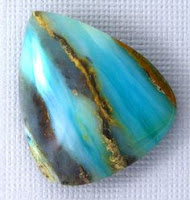
Peruvian opal (also called blue opal)
Is a semiopaque to opaque blue-green stone found in Peru, which is often cut to include the matrix in the more opaque stones. It does not display pleochroism. Blue opal also comes from Oregon in the Owhyee region, as well as from Nevada around Virgin Valley.
Sources of opal
Australian opal
Australia produces around 97% of the world’s opal; 90% is called light opal or white and crystal opal. White makes up 60% of the opal production, but cannot be found in all of the opal fields. Crystal opal or pure hydrated silica makes up 30% of the opal produced, 8% is black and only 2% is boulder opal.
The town of Coober Pedy in South Australia is a major source of opal. The world’s largest and most valuable gem opal “Olympic Australis” was found in August 1956 at the “Eight Mile” opal field in Coober Pedy. It weighs 17,000 carats (3450 g) and is 11 in (280 mm) long, with a height of 4.75 in (121 mm) and a width of 4.5 in (110 mm). The Mintabie Opal Field located about 250 km (160 mi) north west of Coober Pedy has also produced large quantities of crystal opal and the rarer black opal. Over the years, it has been sold overseas incorrectly as Coober Pedy opal. The black opal is said to be some of the best examples found in Australia. Andamooka in South Australia is also a major producer of matrix opal, crystal opal, and black opal’. Another Australian town, Lightning Ridge in New South Wales, is the main source of black opal, opal containing a predominantly dark background (dark-gray to blue-black displaying the play of color). Boulder opal consists of concretions and fracture fillings in a dark siliceous ironstone matrix. It is found sporadically in western Queensland, from Kynuna in the north, to Yowah and Koroit in the south. Its largest quantities are found around Jundah and Quilpie (known as the “home of the boulder opal”) in South West Queensland. Australia also has opalised fossil remains, including dinosaur bones in New South Wales, and marine creatures in South Australia. The rarest type of Australian opal is “pipe” opal, closely related to boulder opal, which forms in sandstone with some iron oxide content, usually as fossilized tree roots.
Ethiopian opal
Nodule of gem-grade precious Ethiopian Welo opal
Although it has been reported that Northern African opal was used to make tools as early as 4000 BC, the first published report of gem opal from Ethiopia appeared in the 1994, with the discovery of precious opal in the Menz Gishe District, North Shewa Province. The opal, found mostly in the form of nodules, was of volcanic origin and was found predominantly within weathered layers of rhyolite. This Shewa Province opal, was mostly dark brown in color, and had a tendency to crack. These qualities made it unpopular in the gem trade. In 2008, a new opal deposit was found near the town of Wegel Tena, in Ethiopia’s Wollo Province. The Wollo Province opal was different from the previous Ethiopian opal finds in that it more closely resembled the sedimentary opals of Australia and Brazil, with a light background and often vivid play-of-color. Wollo Province opal, more commonly referred to as “Welo” or “Wello” opal has become the dominant Ethiopian opal in the gem trade.
Virgin Valley, Nevada
The Virgin Valley opal fields of Humboldt County in northern Nevada produce a wide variety of precious black, crystal, white, fire, and lemon opal. The black fire opal is the official gemstone of Nevada. Most of the precious opal is partial wood replacement. The precious opal is hosted and found within a subsurface horizon or zone of bentonite in-place which is considered a “lode” deposit. Opals which have weathered out of the in-place deposits are alluvial and considered placer deposits. Miocene-age opalised teeth, bones, fish, and a snake head have been found. Some of the opal has high water content and may desiccate and crack when dried. The largest producing mines of Virgin Valley have been the famous Rainbow Ridge, Royal Peacock, Bonanza, Opal Queen, and WRT Stonetree/Black Beauty Mines. The largest unpolished black opal in the Smithsonian Institution, known as the “Roebling opal”, came out of the tunneled portion of the Rainbow Ridge Mine in 1917, and weighs 2,585 carats. The largest polished black opal in the Smithsonian Institution comes from the Royal Peacock opal mine in the Virgin Valley, weighing 160 carats, known as the “Black Peacock”.
Other locations
Another source of white base opal or creamy opal in the United States is Spencer, Idaho. A high percentage of the opal found there occurs in thin layers.
Other significant deposits of precious opal around the world can be found in the Czech Republic, Slovakia, Hungary, Turkey, Indonesia, Brazil (in Pedro II, Piauí), Honduras Erandique-LempiraLempira Department, Guatemala and Nicaragua.
In late 2008, NASA announced it had discovered opal deposits on Mars.
Reference:
Wikipedia










